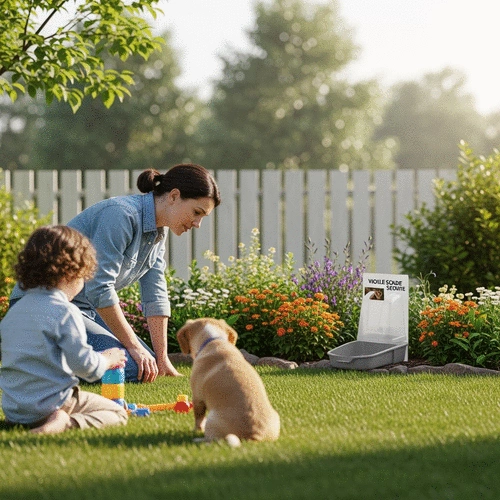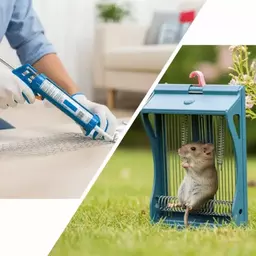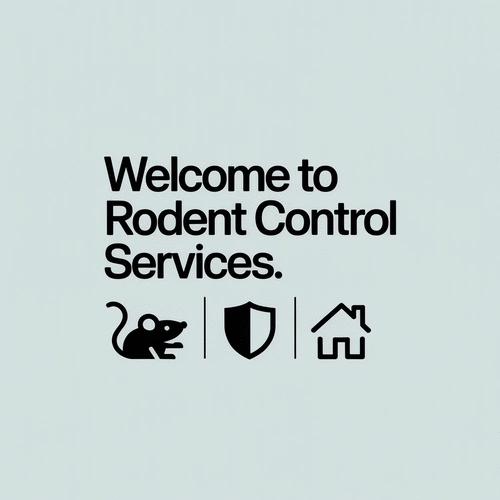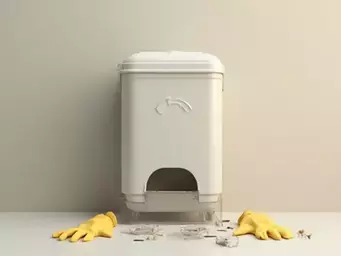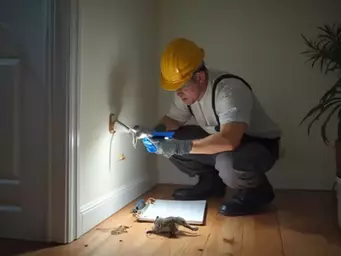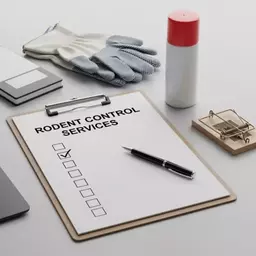As we navigate the complexities of maintaining a rodent-free home, it's vital to consider safety as a top priority. With the right knowledge, we can protect our loved ones while effectively managing pest issues.
What You Will Learn
- Understand the Risks: Be aware of the potential dangers associated with rodenticides for non-target species.
- Prioritize Safe Storage: Ensure that all rodenticides are stored securely to prevent accidental exposure.
- Utilize Tamper-Resistant Stations: These stations can help keep bait out of reach of children and pets, enhancing overall safety.
- Explore Non-Toxic Options: Consider using non-toxic bait alternatives that are safer for your family and the environment.
Rodent Baiting Safety: Risks and Protective Measures
This visual summarizes the key concerns associated with rodenticides and the essential strategies for ensuring safety in your home.
Why Rodent Baiting Safety Matters
Rodenticides pose potential threats to non-target species and the environment. Prioritizing safety creates healthier environments and prevents unintended harm.
- Children Protection: Kids are curious and unaware of dangers.
- Pet Safeguarding: Furry friends may ingest bait as a treat.
- Wildlife Protection: Rodenticides can harm species consuming poisoned rodents.
Common Concerns & Dangers
Rodenticides can contaminate the environment and lead to health issues for non-target species, including humans and pets.
- Accidental Poisoning: Risks to pets and wildlife.
- Environmental Impact: Contamination of soil and water.
- Health Risks: Direct exposure can cause serious complications.
- Resistance: Rodents can develop resistance over time.
Effective Safety Strategies
Implementing safe practices is crucial for effective rodent management while minimizing risks to your family and environment.
- Understand Risks: Be aware of non-target species dangers.
- Safe Storage: Securely store all rodenticides.
- Tamper-Resistant Stations: Keep bait out of reach.
- Non-Toxic Options: Consider safer alternatives.
Understanding Rodent Baiting Safety for a Healthier Home
When it comes to keeping our homes rodent-free, ensuring rodent baiting safety is crucial for the well-being of our family and pets. In my years of experience at Rodent Control Services, I’ve seen firsthand how important it is to consider the safety of children, pets, and even local wildlife when using rodenticides. These substances can be effective, but they also bring risks that need to be managed responsibly.
Acknowledging these risks helps homeowners make informed decisions. By prioritizing safety, we can create healthier environments and prevent unintended harm to our loved ones. Let's dive into why rodent baiting safety matters!
Why Rodent Baiting Safety Matters
Rodenticides can be a double-edged sword. On one hand, they can effectively reduce rodent populations, while on the other, they pose potential threats. Just think about it—children and pets are naturally curious! They might stumble upon bait stations or poisoned rodents, leading to dangerous situations.
- Protecting Children: Kids are often unaware of the dangers lurking around them, making safety precautions absolutely necessary.
- Safeguarding Pets: Our furry friends may see bait as a treat, which can lead to serious health complications.
- Wildlife Protection: Rodenticides can affect local wildlife, harming species that might consume the poisoned rodents.
Taking these aspects into account not only protects our immediate family but also contributes to a healthier ecosystem. It’s a responsibility we must all embrace!
Common Concerns About Rodenticides
Many users worry about the risks associated with using rodenticides. One common question is: how do these chemicals affect non-target species? This is a valid concern because rodenticides can contaminate the environment through various means. For instance, if a rodent dies after consuming bait, other animals may ingest it, leading to a cascade of problems. The EPA has put restrictions on certain rodenticide products to mitigate these risks, highlighting the importance of understanding their proper use and disposal.
- Accidental Poisoning: Non-target species, including pets and wildlife, can suffer from accidental ingestion.
- Environmental Impact: The chemicals can seep into the soil and water sources, affecting the entire ecosystem.
- Resistance Development: Over time, rodent populations can develop resistance to certain rodenticides, making them less effective.
Addressing these concerns is key to creating a balanced approach to pest management. At Rodent Control Services, we believe in educating our clients on these risks so they can choose safer options.
Understanding the Dangers of Rodenticides
The potential health risks posed by rodenticides cannot be overlooked. Exposure to these chemicals can lead to significant health issues—not just for rodents but for humans and pets as well. For example, the toxins can cause varying symptoms, from mild gastrointestinal distress to severe neurological damage. The USDA provides fact sheets on rodenticides, detailing their effects and safe handling practices, which are crucial for minimizing risks.
- Disease Transmission: Rodents can carry diseases, and poisoned rodents can still pose a risk if their bodies are not disposed of properly.
- Chemical Exposure: Direct contact or ingestion of rodenticides may lead to serious health complications for pets and children.
- Long-Term Effects: Prolonged exposure can result in chronic health conditions, which is why understanding these dangers is vital for every household.
By recognizing these dangers, we can make informed decisions about pest control methods that prioritize safety and sustainability. Remember, it’s always better to err on the side of caution!
Effective Strategies for Protecting Children and Pets
Now that we've established the importance of rodent baiting safety, let's explore effective strategies for ensuring our homes remain safe during pest control efforts. California, for instance, has implemented stronger rat poison restrictions, setting a precedent for safer pest management practices.
Engage with Us!
Have you ever thought about the long-term effects of rodent baiting in your home? Understanding the bigger picture is vital for making informed decisions. We want to hear from you! Share your experiences or concerns regarding rodent control methods:
Frequently Asked Questions About Rodent Baiting Safety
Q: What are the main risks associated with rodenticides?
A: The main risks include accidental poisoning of children, pets, and wildlife, environmental contamination (soil and water), and the potential for rodents to develop resistance over time.
Q: How can I protect my children and pets from rodenticides?
A: You can protect them by prioritizing safe storage of all rodenticides, utilizing tamper-resistant bait stations that keep bait out of reach, and considering non-toxic alternatives for pest control.
Q: Are there safer alternatives to traditional rodenticides?
A: Yes, the article encourages exploring non-toxic bait options and other effective strategies that do not pose a risk to non-target species or the environment.
Q: What is the environmental impact of rodenticides?
A: Rodenticides can contaminate the environment by seeping into soil and water sources. Additionally, poisoned rodents can be consumed by other animals, leading to secondary poisoning throughout the ecosystem.
Q: Why is safe disposal of poisoned rodents important?
A: Safe disposal is crucial because poisoned rodents can still transmit diseases and pose a risk of secondary poisoning to other animals if not handled properly.
Summarizing Key Takeaways on Rodent Baiting Safety
As we wrap up our discussion on rodent baiting safety, it’s crucial to highlight the key points that can help ensure a healthier home environment. First and foremost, prioritizing the safety of our children, pets, and wildlife is essential when using rodenticides. By implementing safe practices, we can effectively manage rodent issues while minimizing risks.
Here are the main takeaways to consider:
- Understand the Risks: Be aware of the potential dangers associated with rodenticides for non-target species.
- Prioritize Safe Storage: Ensure that all rodenticides are stored securely to prevent accidental exposure.
- Utilize Tamper-Resistant Stations: These stations can help keep bait out of reach of children and pets, enhancing overall safety.
- Explore Non-Toxic Options: Consider using non-toxic bait alternatives that are safer for your family and the environment.
By keeping these points in mind, we can create a proactive approach to pest control that safeguards our loved ones while effectively addressing rodent challenges.
Encouraging Safe Pest Control Practices
As you read through this article, I encourage you to adopt safe rodent baiting methods in your homes. Each small step you take can make a significant difference in ensuring a safe environment for everyone. If you haven’t already, consider exploring non-toxic alternatives that can provide effective pest control without compromising safety.
Have you had experiences with rodent control in your home? I invite you to share your thoughts or questions! At Rodent Control Services, I’m here to help you navigate your pest management journey. Together, let’s foster a rodent-free environment that is safe for all.
Recap of Key Points
Here is a quick recap of the important points discussed in the article:
- Understand the Risks: Be aware of the potential dangers associated with rodenticides for non-target species.
- Prioritize Safe Storage: Ensure that all rodenticides are stored securely to prevent accidental exposure.
- Utilize Tamper-Resistant Stations: These stations can help keep bait out of reach of children and pets, enhancing overall safety.
- Explore Non-Toxic Options: Consider using non-toxic bait alternatives that are safer for your family and the environment.

